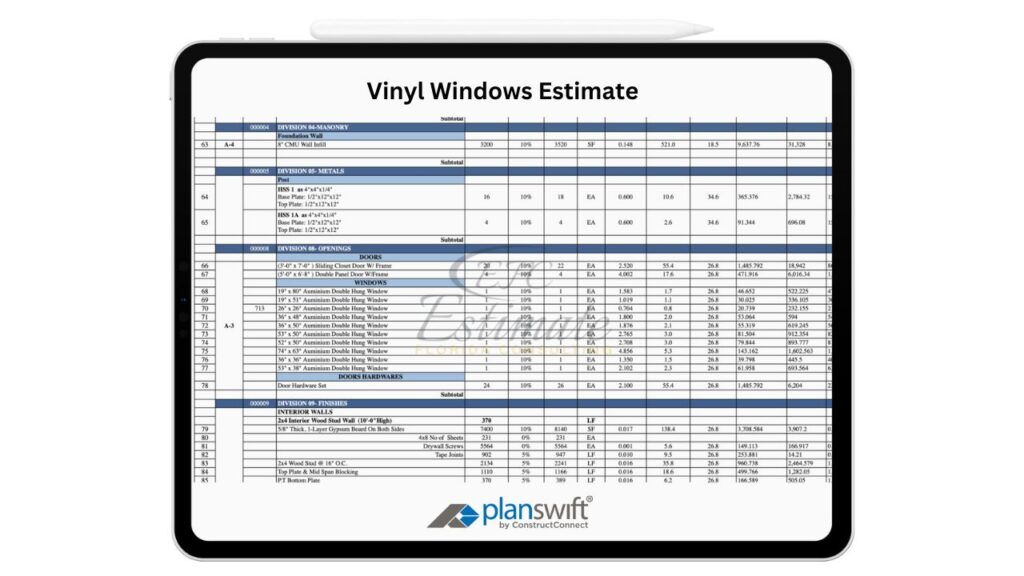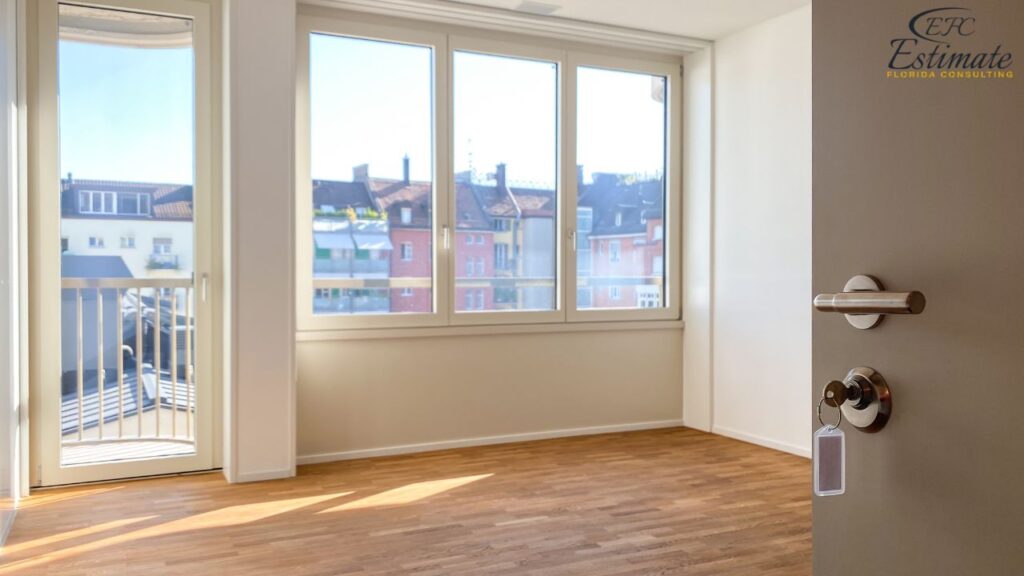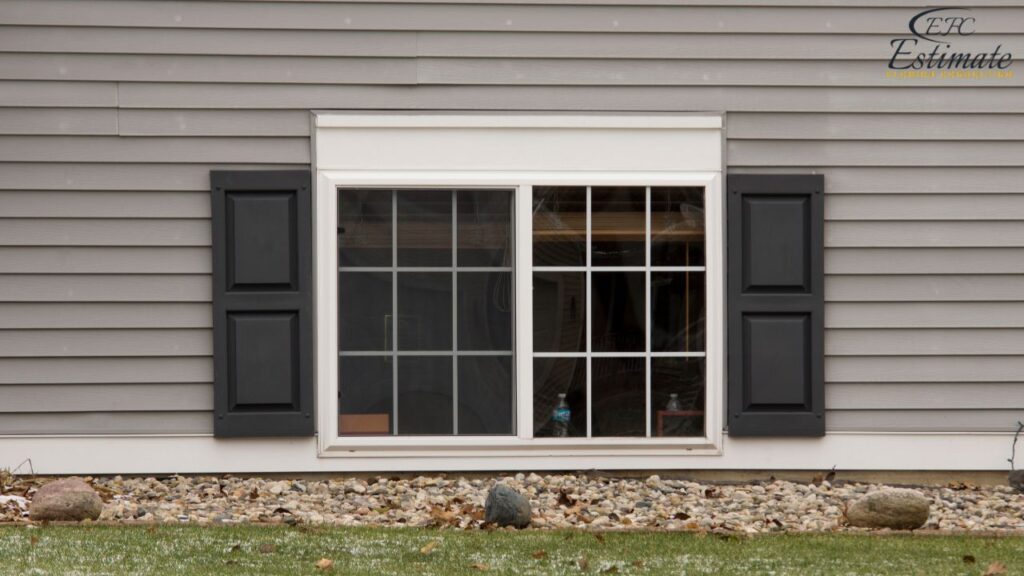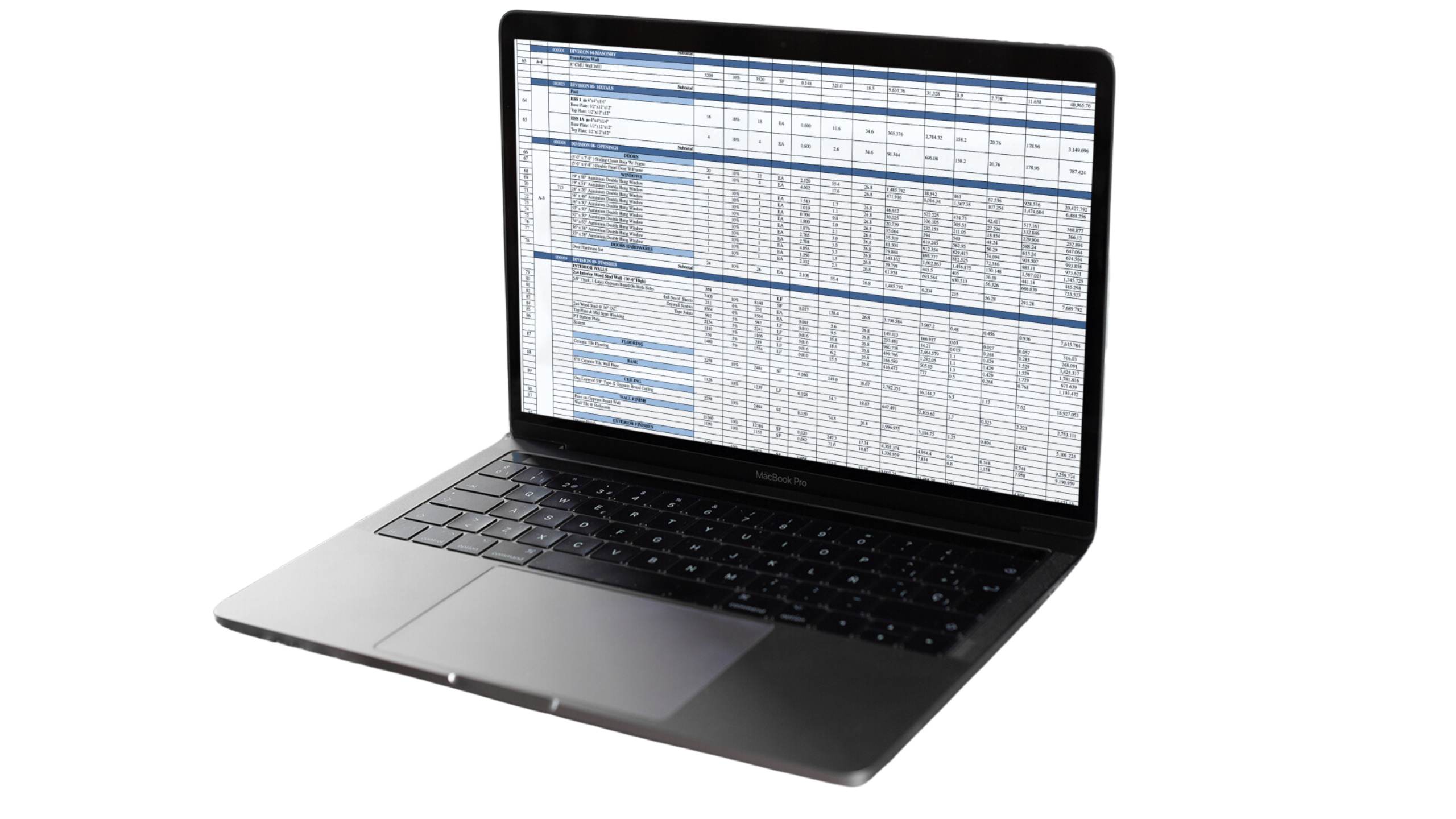90% More Chances to Win Projects With Our Estimate!
- Multi-Family Building
- Hotel Building
- Hospital Building
- Warehouse Building
- School & University Building
- High-Rise Building
- Shopping Complex
- Data Center Building

The average cost to install replacement vinyl windows in 2024 is now between $469 and $1,001 per window, including both materials and installation. Vinyl windows are typically the most budget-friendly option for window frames. On average, the national cost for replacing a window is around $657, but this can vary depending on factors such as the window brand, whether it’s a single- or double-pane window, the style of the window, and local labor rates.

The size of the window has a direct impact on both the material and labor costs. Here is an average cost breakdown based on window size:
Window Size | Average Cost per Window |
Small (Less than 3 ft) | $250 – $500 |
Medium (3-5 ft) | $400 – $700 |
Large (Over 5 ft) | $700 – $1,200 |
On average, homeowners can expect to pay between $300 and $800 per window, including both the cost of the window itself and installation. The final price will depend on the factors mentioned above, as well as any additional features or upgrades selected.
Type of Vinyl Window | Average Cost (Window Only) | Average Installation Cost | Total Average Cost |
Double-Hung | $200 – $400 | $100 – $200 | $300 – $600 |
Casement | $250 – $500 | $100 – $250 | $350 – $750 |
Sliding | $200 – $400 | $100 – $200 | $300 – $600 |
Picture | $250 – $600 | $100 – $250 | $350 – $850 |
Bay and Bow | $800 – $2,000 | $300 – $600 | $1,100 – $2,600 |
The table above presents an overview of the average costs associated with various styles of vinyl windows, providing a clearer picture for homeowners considering their options.
Replacement vinyl windows are the most popular type of window frame installed in homes today. Made from PVC or polyvinyl chloride (uPVC), these windows are mixed with various chemicals and pigments to give them the desired color and durability to withstand sunlight and harsh weather conditions. Vinyl windows won’t peel, crack, bend, or warp, making them incredibly durable and an excellent option for energy-efficient window installations.
Double-hung vinyl windows are characterized by two sashes that slide vertically. They are popular for their traditional look and ease of operation. On average, the total cost for double-hung windows ranges from $300 to $600.
Casement windows hinge on the side and open outward, offering excellent ventilation. The total cost for casement windows typically falls between $350 and $750, reflecting their more complex design and installation process.
Sliding windows operate by sliding horizontally along a track. They are often more affordable, with total costs ranging from $300 to $600. Their straightforward installation process contributes to lower labor costs.
Picture windows are large, fixed windows that offer unobstructed views. While they don’t open, they can add significant natural light to a room.
The total cost for picture windows ranges from $350 to $850, depending on size and installation complexity.

Bay and bow windows project out from the house and typically consist of multiple window units. Due to their size and complexity, they are the most expensive option, with total costs ranging from $1,100 to $2,600.
Here are the top reasons why homeowners are choosing replacement vinyl windows in 2024:
Compared to other window frame materials like aluminum, wood, and fiberglass, vinyl windows remain the most cost-effective. Even high-end vinyl windows are now 20% more affordable than entry-level wood or aluminum windows, making them a smart financial choice without compromising on quality.
Vinyl windows come in a wide variety of designs and styles. Whether you’re looking for casement windows, picture windows, double-hung, single-hung, or even architectural styles, vinyl can accommodate all of them. High-quality vinyl frames, especially those with insulated hollow pockets, can offer the same energy efficiency as wood windows, providing great performance and savings on energy costs.
Vinyl windows require very little upkeep. Aside from the occasional cleaning, you won’t need to worry about painting or maintaining them over time. They retain their appearance and functionality with minimal effort, saving homeowners both time and money on maintenance.
While vinyl windows offer many benefits, it’s important to consider the following factors before making a decision:
Vinyl window frames are less durable compared to other materials. The PVC they are made from is more prone to damage and can fade over time. However, advancements in chemical treatments used during manufacturing help preserve the look and durability of vinyl windows much better than before. If you’re concerned about durability, a clad wood window with vinyl components may be a better choice, as it combines the benefits of both materials.
Vinyl windows generally have a shorter lifespan compared to aluminum or wood options. While some paint products are available for vinyl windows, they can be tricky to apply and are limited in color choices. Most homeowners opt to replace vinyl windows every 12 to 24 years, rather than repaint them. Though they offer affordability upfront, the need for earlier replacement should be factored into long-term planning.

As of 2024, the cost of replacement vinyl windows ranges from $469 to $1,001 per window, with a national average of $657 per window. This price includes both the cost of materials and labor for installation. Vinyl windows continue to be an affordable and popular option among homeowners due to their durability and energy efficiency.
Most major window manufacturers offer vinyl windows, given their widespread popularity. Standard-size vinyl windows are now priced between $342 and $730 per window, though this cost does not include installation. Selecting the right brand is crucial for ensuring quality window frames, long-lasting warranties, and unique design options.
Vinyl windows generally have a shorter lifespan compared to aluminum or wood options. While some paint products are available for vinyl windows, they can be tricky to apply and are limited in color choices. Most homeowners opt to replace vinyl windows every 12 to 24 years, rather than repaint them. Though they offer affordability upfront, the need for earlier replacement should be factored into long-term planning.

Not all vinyl windows are created equal, so it’s important to recognize the qualities that make a window durable and energy efficient. Below are key factors to consider when selecting replacement vinyl windows.
One way to assess quality is by examining the frame’s cross-section. Quality vinyl windows typically have more, smaller chambers, which makes them more durable and weather-resistant. Windows fastened with screws and caulk tend to be less reliable than those with welded seams, as welded frames offer better long-term performance.
Look for windows that come with a “double lifetime” warranty. These warranties not only cover you as the homeowner but also transfer to future owners if you decide to sell your home, adding extra value to your property.
Top manufacturers like Simonton and Harvey are known for their high-quality vinyl windows. Comparing their products against competitors will give you an idea of which offers superior construction, better warranties, and long-term reliability.
Ensure the vinyl windows you select have double or triple-pane glass, treated with coatings to maximize energy efficiency. For homes in high-traffic or storm-prone areas, consider impact-resistant glass for added security and durability.
Labor costs for vinyl window installation vary based on the complexity of the project and local rates. On average, expect to pay between $100 and $250 per window for labor. This price can increase if the installation involves structural changes, window resizing, or removing old windows.
Vinyl window installations often include optional upgrades that can add to the overall cost. Popular upgrades include:
These additional features enhance both the functionality and appearance of the windows but come with additional costs.

Upgrading to energy-efficient vinyl windows can increase the overall cost by 10% to 30%, but these features can lead to significant savings on energy bills over time.
Adding grids or decorative patterns to vinyl windows can enhance their appearance. Expect to pay an additional $50 to $150 per window for these aesthetic upgrades.
Window tinting is an effective way to reduce glare and improve energy efficiency. The cost for window tinting typically ranges from $50 to $100 per window, depending on the type of film used.
While some homeowners may consider a DIY approach to window installation, it’s essential to weigh the pros and cons. DIY installations can save money on labor costs but may lead to issues if not done correctly. Professional installation, while more expensive, typically includes warranties and ensures that windows are properly fitted and sealed.
Installing vinyl windows can significantly enhance the energy efficiency and aesthetic appeal of your home. Understanding the costs associated with vinyl window installation, including materials, styles, and additional features, is crucial for making informed decisions. Whether you opt for a DIY installation or hire a professional, knowing the average costs will help you budget effectively for this home improvement project.
Vinyl windows typically have a lifespan of 20 to 40 years, depending on the quality of materials and maintenance.
Yes, vinyl windows can be very energy-efficient, especially those with double or triple glazing and low-E coatings.
While it is possible to paint vinyl windows, it's not typically recommended due to potential issues with adhesion and warranty coverage.
Regular cleaning and inspection are key to maintaining vinyl windows. Use a mild detergent and water, and check for any damage to seals or frames.
Yes, vinyl windows offer long-term savings on energy costs and require less maintenance compared to other materials, making them a worthwhile investment for homeowners.
At Estimate Florida Consulting, we offer detailed cost estimates across all major trades, ensuring no part of your project is overlooked. From the foundation to the finishing touches, our trade-specific estimates provide you with a complete and accurate breakdown of costs for any type of construction project.

We take pride in delivering accurate, timely, and reliable estimates that help contractors and builders win more projects. Our clients consistently praise our attention to detail, fast turnaround times, and the positive impact our estimates have on their businesses.
Estimate Florida Consulting has helped us win more bids with their fast and accurate estimates. We trust them for every project!

Submit your project plans, blueprints, or relevant documents through our online form or via email.
We’ll review your project details and send you a quote based on your scope and requirements.
Confirm the details and finalize any adjustments to ensure the estimate meets your project needs.
Receive your detailed, trade-specific estimate within 1-2 business days, ready for your project execution.

561-530-2845
info@estimatorflorida.com
Address
5245 Wiles Rd Apt 3-102 St. Pete Beach, FL 33073 United States
561-530-2845
info@estimatorflorida.com
Address
5245 Wiles Rd Apt 3-102 St. Pete Beach, FL 33073 United States
All copyright © Reserved | Designed By V Marketing Media | Disclaimer